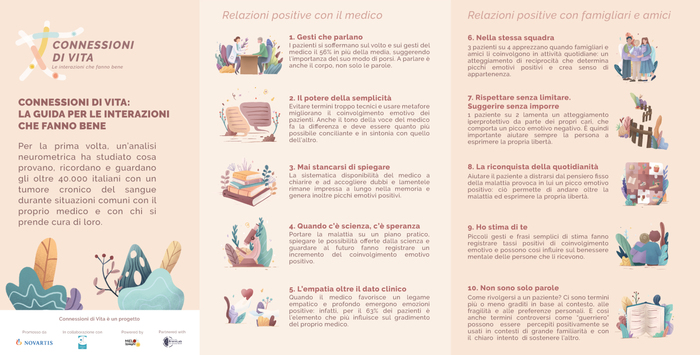(ANSA) – ROM, JULY 06 – What do people who live with chronic blood cancer look at, remember and feel? The eyes linger on the doctor’s face and gestures 56% more than the average, while the willingness of the hematologist to clarify even the most difficult concepts remains etched in the memory for a long time. On the other hand, generating intense emotional peaks, detected by the heartbeat and skin sweating, is the ability of family members to distract the patient from the fixed thought of the disease. This was highlighted by a neurometric analysis, which used various instruments and sensors including the 52-channel electroencephalograph, on the interactions that patients with chronic myeloproliferative neoplasms and chronic myeloid leukemia experience with their doctors, family and friends.
Connessioni di Vita was born from the results of the study – conducted by the Behavior and Brain Lab research center of the IULM University of Milan. The guide for healthy interactions, promoted by Novartis in collaboration with Aipamm, the Association of Patients with Myeloproliferative Diseases, as part of the Mielo-Spieghi awareness campaign.
A handbook with 10 tips for building positive and quality relationships: in fact, the small gestures, words and interactions that over 40,000 Italian patients establish with doctors and their loved ones have a direct impact on their mental well-being and are able to make a difference in the path of disease of a chronic blood cancer.
“We were able to observe – explains Vincenzo Russo, Professor of Consumer Psychology and Neuromarketing, Iulm University – the activation of the different areas of the brain during interactions with doctors and caregivers, measure the heart rate and sweating of the hands to understand the emotional intensity , examine eye movement to understand what they are paying attention to most. This has allowed us to go beyond what patients say.” Patients tend to observe the hematologist’s face and gestures, as well as his ability to show attention and closeness: for 63% this is precisely the element that most influences the satisfaction of the doctor. And if 1 out of 2 patients complain of overprotective behavior from their loved ones, 3 out of 4 say they appreciate it when family and friends involve them in daily activities: an attitude of reciprocity that leads to positive emotional peaks. (HANDLE).
breaking latest news © Copyright ANSA
]]>
]]>
Get the embed code
]]>
]]>
]]>
